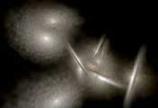Unbelievably dense, and forming stars quickly
A massive galaxy cluster that formed 12 billion years ago is shedding new light on our universe’s structures.
Galaxy clusters are the largest objects in our universe. With masses comparable to a million-billion suns, they contain as many as 1,000 galaxies, vast amounts of dark matter, gargantuan black holes and X-ray-emitting gases that reach more than a million degrees Kelvin.
A dense concentration of galaxies recently discovered by a team including numerous UVic researchers is now causing astrophysicists to question our understanding of how structures form in the universe. Their study, published this week in Nature, reports on a collection of galaxies as they were manifest when the universe was about one-tenth of its present age.
This particular galaxy cluster is so far away it takes 12.4 billion years for light from it to reach Earth. So while it was first observed last year, it was seen as it existed 1.4 billion years after the Big Bang—allowing astronomers a rare peek into galaxies forming in the early history of the universe.
The team of researchers—from institutions including University of Victoria, the National Research Council of Canada, Dalhousie University and the Flatiron Institute—have discovered a cluster of galaxies assembling very differently and more quickly than current models would predict. The nascent cluster is made up of at least 14 galaxies packed into a region of space just three times the size of our Milky Way galaxy—and each is forming stars up to 1,000 times faster than ours is forming them. Calculations indicate that the astronomers are witnessing the assembly of one of the most massive structures in the present-day universe.
- Related: CBC News story
The study was co-led by Scott Chapman, UVic Adjunct Professor and Research Officer at the National Research Council of Canada and Professor at Dalhousie University, and Tim Miller, as a Master’s student at Dalhousie University. It was co-authored by a team of scientists including UVic Distinguished Professor, Arif Babul; astrophysics doctoral student, Douglas Rennehan; UVic advanced research computing specialist, Belaid Moa; University of Illinois Professor, Joaquin Vieira; and Christopher Hayward, Associate Research Scientist at the Centre for Computation Astrophysics, Flatiron Institute.
“Having caught a massive galaxy cluster, and especially its gigantic central galaxy, in the throes of formation is spectacular in and of itself,” explains Babul. “But, the fact that this is happening so early in the history of the universe and in so dramatic a fashion poses a formidable challenge to our understanding of how and when structures in the universe form. Conventional wisdom suggests that the central cluster galaxy is assembled in dribs and drabs spread over 13 billion years, by cannibalizing smaller galaxies that venture too close. This discovery appears to upend this picture.”
To predict how the cluster will assemble, a team led by Arif Babul used Westgrid and Compute Canada supercomputers to develop a numerical simulation. It showed that the core of the cluster will eventually combine into one giant galaxy, over the next billion years. Scientists anticipate that eventually this will prove to be one of the most massive clusters in the current-day universe.
This cluster system, originally discovered by the South Pole Telescope, was studied in detail using the Atacama Large Millimetre-submillimetre Array (ALMA). ALMA has the world’s most advanced radio astronomy detectors, developed by the National Research Council of Canada, which provided the detail necessary for the discovery of the system.

